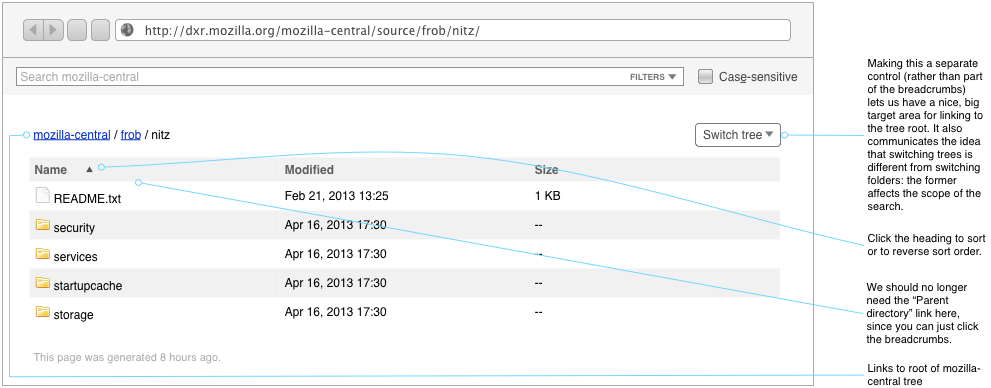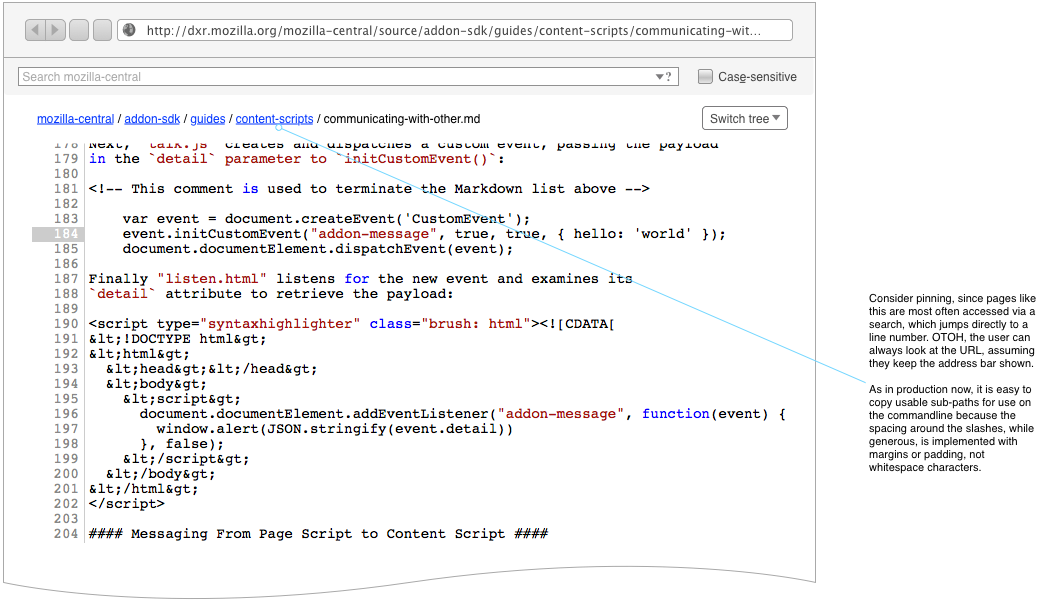DXR UI Refresh: Difference between revisions
(Note a few improvements the initial view makes over the production design.) |
(→Advanced Search: Update text to reflect the scalable advanced search UI that replaces the 24-fields one.) |
||
| Line 21: | Line 21: | ||
== Advanced Search == | == Advanced Search == | ||
Currently, nobody understands when the advanced search | Currently, nobody understands when the advanced search panel shows up. It seems rather random. Now, it'll always be accessible via a disclosure control on the basic search panel. | ||
[[File:Dxr_advanced_search.png]] | [[File:Dxr_advanced_search.png]] | ||
Open questions: | |||
* Should we add a textual signifier to the main search field when something other than ''text'' is chosen—<code>function:foo</code> rather than <code>foo</code>, for instance? There is little reason to support such syntax at all with the pop-up there, since you can select something from the pop-up at least as efficiently as typing out the signifier, assuming type-to-select in the user agent. If DXR grows to support arbitrary boolean expressions (<code>(function:foo OR function:bar) regexp:sme+p</code>), then syntax becomes more useful again. If we do decide to keep the syntax, we'll have to decide what to do with the menu if the user manually changes a signifier—change its selection, dim it, etc. | |||
== Search Results == | == Search Results == | ||
Revision as of 19:25, 9 August 2013
Once upon a time, Schalk Neethling surveyed the userbase and heuristically analyzed the UI, resulting in some nifty mockups.
Then Erik Rose came along and did another round of wireframes adding these simplifications:
- Removing the front page, which not a soul remembers the reason for and which complicates the implementation and visually destabilizes the UI when it goes "poof". (I think the UI was inspired by Google. But, unlike them, we don't have other properties to advertise, so we don't need a place to park a navbar.)
- Teaching the query syntax via live feedback from the advanced search form rather than through written instructions. It's a little more JS, but users won't have to pogo-stick back and forth to a help page.
- Making a few improvements to the multi-tree story
Feel free to comment on Talk:DXR_UI_Refresh and factor up the results of discussion to this page.
Basic Search
- The basic search panel gets an always-present case-sensitivity checkbox, with an accesskey so it can be toggled quickly and without leaving the keyboard.
- A pop-up menu exposes most of the 24 filter types. Users no longer have to check a manual (which never existed) or the source code to see what's available. Also, the presence of a single menu encourages the use of only one filter per query, which is all that makes sense with most filters. (Filters that do make sense in combination with others are available in the advanced search panel.)
Initial Page
DXR's current front page goes away, replaced with a code-browsing view. If we'd like to add a tree description page, a la MXR, we could do it at the root of the browsing hierarchy. Breadcrumbs make clear where you are in the tree and are separated from the search panel to make clearer that browsing location has no effect on search scope.
Advanced Search
Currently, nobody understands when the advanced search panel shows up. It seems rather random. Now, it'll always be accessible via a disclosure control on the basic search panel.
Open questions:
- Should we add a textual signifier to the main search field when something other than text is chosen—
function:foorather thanfoo, for instance? There is little reason to support such syntax at all with the pop-up there, since you can select something from the pop-up at least as efficiently as typing out the signifier, assuming type-to-select in the user agent. If DXR grows to support arbitrary boolean expressions ((function:foo OR function:bar) regexp:sme+p), then syntax becomes more useful again. If we do decide to keep the syntax, we'll have to decide what to do with the menu if the user manually changes a signifier—change its selection, dim it, etc.
Search Results
File View
Other Considerations & Use Cases
- The need for the magnifying glass logo is diminished: we now have plenty of other ways to get back to code-browsing mode. Perhaps we can better use the space for something else.
- The Navigation pane, also something which shows up apparently at random, should be more predictable and should have whatever kind of disclosure control we decide upon for the Advanced Search form.
- Mook switches trees a lot while looking at a single file in MXR. He's like to be able to do that without losing his scroll position, as it typically lands him at a similar-enough place in the code that he can reorient himself. Maybe…
- Move the tree-chooser to the upper right and pin it, or
- Pin the whole search widget (is the advanced search thing too ridiculously big?), or
- Put a little pushpin control on the search bar so you can choose whether it's pinned.
Gallery of Unwanted Advanced-Search Widgets
Just for fun, here's a slagheap of discarded advanced-search disclosers. :-)





